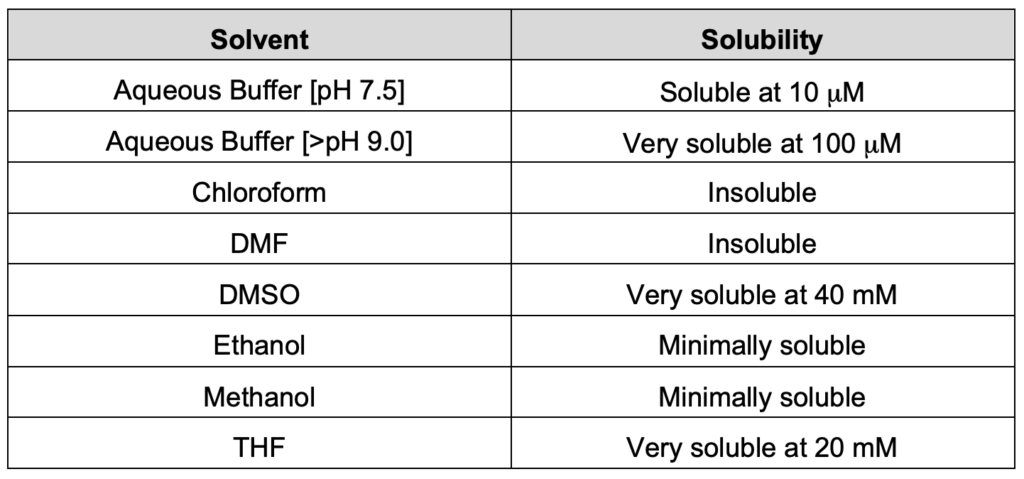Fluorophore-promoted RNA folding and photostability enable imaging of single Broccoli-tagged mRNAs in living mammalian cells. Angewandte Chemie. December 18, 2019. LINK
Highly efficient expression of circular RNA aptamers in cells using autocatalytic transcripts. Nature Biotechnology. June, 2019. LINK
Programmable RNA detection with a fluorescent RNA aptamer using optimized three-way junction formation. RNA. May 16, 2019. LINK
Spectral tuning by a single nucleotide controls the fluorescence properties of a fluorogenic aptamer. ACS Biochemistry. March 6, 2019. LINK
Detection of low-abundance metabolites in live cells using an RNA integrator. Cell Chemical Biology. February 14, 2019. LINK
RNA structures and cellular applications of fluorescent light-up aptamer. Angewandte Chemie. August 13, 2018. LINK
Genetically encoded catalytic hairpin assembly for sensitive RNA imaging in living cells. Journal of the American Chemical Society. June 26, 2018. LINK
Modular cell-internalizing aptamer nanostructure enables targeted delivery of large functional RNAs in cancer cell lines. Nature Communications. June 11, 2018. LINK
Development of genetically encodable FRET system using fluorescent RNA aptamers. Nature Communications. January 2, 2018. LINK
RNA-based fluorescent biosensors for detecting metabolites in vitro and in living cells. Advances in Pharmacology. October 25, 2017. LINK
Using a specific RNA-protein interaction to quench the fluorescent RNA Spinach. ACS Chemical Biology. October 23, 2017. LINK
Imaging RNA polymerase III transcription using a photostable RNA-fluorophore complex. Nature Chemical Biology. September 25, 2017. LINK
A homodimer interface without base pairs in an RNA mimic of red fluorescent protein. Nature Chemical Biology. September 25, 2017. LINK
A tale of two G-quadruplexes. Nature Chemical Biology. September 25, 2017. LINK
FASTmir: an RNA-based sensor for in vitro quantification and live-cell localization of small RNA. Nucleic Acids Research. June 6, 2017. LINK
A fluorescent split aptamer for visualizing RNA-RNA assembly in vivo. ACS Synthetic Biology. September 15, 2017. LINK
Sequence-specific biosensing of DNA target through relay PCR with small-molecule fluorophore. ACS Chemical Biology. May 9, 2016. LINK
Fluorescent RNA aptamers as a tool to study RNA-modifying enzymes. Cell Chemical Biology. March 17, 2016. LINK
A conformation-induced fluorescence method for microRNA detection. Nucleic Acids Research. March 6, 2016. LINK
Tandem Spinach array for mRNA imaging in living bacterial cells. Scientific Reports. November 27, 2015. LINK
Combining Spinach-tagged RNA and gene localization to image gene expression in living yeast. Nature Communications. November 19, 2015. LINK
In-gel imaging of RNA processing using Broccoli reveals optimal aptamer expression. Chemistry & Biology. May 21, 2015. LINK
Imaging metabolite dynamics in living cells using a Spinach-based riboswitch. Proceedings of the National Academy of Sciences of the United States of America. May 11, 2015. LINK
RNA signal amplifier circuit with integrated fluorescence output. ACS Synthetic Biology October 29, 2014. LINK
Broccoli: Rapid selection of an RNA mimic of green fluorescent protein by fluorescence-based selection and directed evolution. Journal of the American Chemical Society. October 22, 2014. LINK
Structural basis for activity of highly efficient RNA mimics of green fluorescent protein. Nature Structural & Molecular Biology. July 15, 2014. LINK
A G-quadruplex-containing RNA activates fluorescence in a GFP-like fluorophore. Nature Chemical Biology. June 22, 2014. LINK
Using Spinach-based sensors for fluorescence imaging of intracellular metabolites and proteins in living bacteria. Nature Protocols. January 9, 2014. LINK
Plug-and-play fluorophores extend the spectral properties of Spinach. Journal of the American Chemical Society. January 6, 2014. LINK
Understanding the Photophysics of the Spinach-DFHBI RNA Aptamer-Fluorogen Complex To Improve Live-Cell RNA Imaging. Journal of the American Chemical Society. December 18, 2013. LINK
E88, a new cyclic-di-GMP class I riboswitch aptamer from Clostridium tetani, has a similar fold to the prototypical class I riboswitch, Vc2, but differentially binds to c-di-GMP analogs. Molecular BioSystems. December 18, 2013. LINK
Gene position more strongly influences cell-free protein expression from operons than T7 transcriptional promoter strength. ACS Synthetic Biology. November 27, 2013. LINK
A superfolding Spinach2 reveals the dynamic nature of trinucleotide repeat-containing RNA. Nature Methods. October 27, 2013. LINK
Unbiased Tracking of the Progression of mRNA and Protein Synthesis in Bulk and in Liposome-Confined Reactions. ChemBioChem. September 11, 2013. LINK
Universal aptamer-based real-time monitoring of enzymatic RNA synthesis. Journal of the American Chemical Society. September 18, 2013. LINK
Programmable folding of fusion RNA in vivo and in vitro driven by pRNA 3WJ motif of phi29 DNA packaging motor. Nucleic Acids Research. September 9, 2013. LINK
Universal aptamer-based real-time monitoring of enzymatic RNA synthesis. Journal of the American Chemical Society. August 30, 2013. LINK
The Spinach RNA Aptamer as a Characterization Tool for Synthetic Biology. ACS Synthetic Biology. August 30, 2013. LINK
New approaches for sensing metabolites and proteins in live cells using RNA. Current Opinion in Chemical Biology. August, 2013. LINK
Imaging bacterial protein expression using genetically encoded RNA sensors composed of RNA. Nature Methods. July 21, 2013. LINK
Designer nucleic acids to probe and program the cell. Trends in Cell Biology. December, 2012. LINK
Nanomolar fluorescent detection of c-di-GMP using a modular aptamer strategy. Chemical Communications. July 20, 2012. LINK
Fluorescence imaging of cellular metabolites with RNA. Science. March 9, 2012. LINK
RNA mimics of green fluorescent protein. Science. July 29, 2011. LINK
